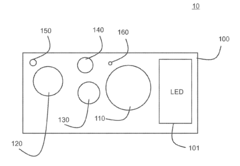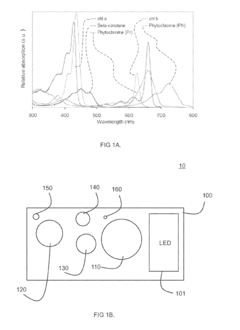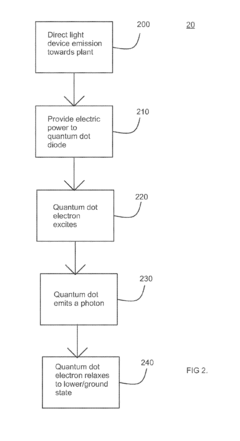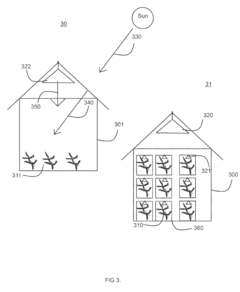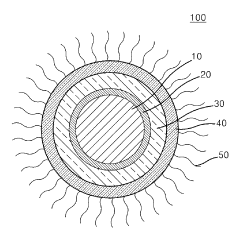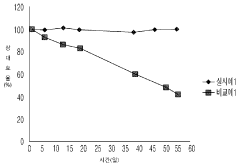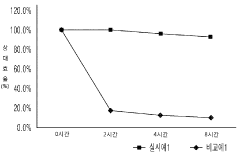Quantum Dot Stability in Agricultural Remote Sensing
SEP 28, 202510 MIN READ
Generate Your Research Report Instantly with AI Agent
Patsnap Eureka helps you evaluate technical feasibility & market potential.
Quantum Dot Technology Evolution and Objectives
Quantum dots (QDs) have emerged as a revolutionary nanomaterial technology with significant potential in agricultural remote sensing applications. Since their discovery in the 1980s, these semiconductor nanocrystals have evolved from laboratory curiosities to practical sensing tools due to their unique optical properties, including size-dependent emission wavelengths, high quantum yields, and broad absorption spectra.
The evolution of quantum dot technology has followed several distinct phases. Initially, cadmium-based QDs (CdSe, CdTe) dominated research efforts due to their excellent luminescent properties. However, concerns regarding heavy metal toxicity led to the development of more environmentally friendly alternatives, including indium phosphide (InP), copper indium sulfide (CIS), and carbon-based quantum dots. This transition marks a critical evolutionary step toward sustainable agricultural applications.
Surface engineering represents another significant advancement in QD technology. Early quantum dots suffered from rapid photobleaching and oxidation when exposed to environmental conditions, severely limiting their utility in field-based agricultural sensing. The development of core-shell structures (such as CdSe/ZnS) and various surface ligand strategies has dramatically improved stability while maintaining optical performance.
Manufacturing scalability has also progressed substantially. Early synthetic methods produced small quantities of QDs with variable quality, whereas modern approaches like continuous flow reactors and microfluidic synthesis enable consistent, large-scale production necessary for widespread agricultural implementation. This manufacturing evolution has coincided with significant cost reductions, making QD technology increasingly accessible for agricultural applications.
The primary technical objective regarding quantum dots in agricultural remote sensing is achieving long-term stability under harsh field conditions. QDs must maintain their optical properties despite exposure to UV radiation, temperature fluctuations, humidity, and various agricultural chemicals. Current research aims to develop encapsulation methods and protective matrices that preserve QD functionality without compromising sensing performance.
Another critical objective is the development of specific surface functionalization strategies that enable selective detection of agricultural parameters such as soil nutrients, plant stress hormones, and pathogen biomarkers. This requires precise control over surface chemistry while maintaining colloidal stability in complex biological matrices.
Integration with existing agricultural sensing platforms represents a further technical goal. Efforts are underway to incorporate QDs into drone-mounted sensors, handheld devices, and automated field monitoring systems that can provide real-time data on crop health and environmental conditions. This integration necessitates addressing challenges in signal processing, calibration stability, and data interpretation algorithms specific to QD-based sensing.
The evolution of quantum dot technology has followed several distinct phases. Initially, cadmium-based QDs (CdSe, CdTe) dominated research efforts due to their excellent luminescent properties. However, concerns regarding heavy metal toxicity led to the development of more environmentally friendly alternatives, including indium phosphide (InP), copper indium sulfide (CIS), and carbon-based quantum dots. This transition marks a critical evolutionary step toward sustainable agricultural applications.
Surface engineering represents another significant advancement in QD technology. Early quantum dots suffered from rapid photobleaching and oxidation when exposed to environmental conditions, severely limiting their utility in field-based agricultural sensing. The development of core-shell structures (such as CdSe/ZnS) and various surface ligand strategies has dramatically improved stability while maintaining optical performance.
Manufacturing scalability has also progressed substantially. Early synthetic methods produced small quantities of QDs with variable quality, whereas modern approaches like continuous flow reactors and microfluidic synthesis enable consistent, large-scale production necessary for widespread agricultural implementation. This manufacturing evolution has coincided with significant cost reductions, making QD technology increasingly accessible for agricultural applications.
The primary technical objective regarding quantum dots in agricultural remote sensing is achieving long-term stability under harsh field conditions. QDs must maintain their optical properties despite exposure to UV radiation, temperature fluctuations, humidity, and various agricultural chemicals. Current research aims to develop encapsulation methods and protective matrices that preserve QD functionality without compromising sensing performance.
Another critical objective is the development of specific surface functionalization strategies that enable selective detection of agricultural parameters such as soil nutrients, plant stress hormones, and pathogen biomarkers. This requires precise control over surface chemistry while maintaining colloidal stability in complex biological matrices.
Integration with existing agricultural sensing platforms represents a further technical goal. Efforts are underway to incorporate QDs into drone-mounted sensors, handheld devices, and automated field monitoring systems that can provide real-time data on crop health and environmental conditions. This integration necessitates addressing challenges in signal processing, calibration stability, and data interpretation algorithms specific to QD-based sensing.
Agricultural Remote Sensing Market Analysis
The agricultural remote sensing market has experienced significant growth over the past decade, driven by increasing demand for precision farming solutions and sustainable agricultural practices. Currently valued at approximately 2.3 billion USD in 2023, the market is projected to reach 4.1 billion USD by 2028, representing a compound annual growth rate (CAGR) of 12.3%. This growth trajectory is supported by the integration of advanced technologies like quantum dots in sensing applications, which enhance data collection accuracy and reliability.
The market segmentation reveals distinct application areas where quantum dot-based remote sensing technologies show particular promise. Crop monitoring represents the largest segment at 38% of the market share, followed by soil analysis (24%), irrigation management (18%), pest and disease detection (12%), and yield prediction (8%). These segments demonstrate varying levels of quantum dot technology adoption, with crop health monitoring showing the fastest integration rate due to the superior spectral sensitivity that quantum dots provide.
Regional analysis indicates North America currently leads the agricultural remote sensing market with 34% share, followed by Europe (28%), Asia-Pacific (25%), Latin America (8%), and Middle East & Africa (5%). However, the Asia-Pacific region is experiencing the fastest growth rate at 15.7% annually, driven by rapid agricultural modernization in China and India, where quantum dot technology is increasingly being deployed in large-scale farming operations.
Key market drivers include the growing global food security concerns, increasing adoption of precision agriculture practices, and supportive government policies promoting sustainable farming techniques. The integration of quantum dot technology specifically addresses the market need for higher resolution imaging and more accurate spectral analysis in varying environmental conditions, which traditional sensing technologies struggle to provide consistently.
Market challenges primarily revolve around the high initial implementation costs of advanced sensing technologies, particularly those incorporating quantum dots, which remain 30-40% more expensive than conventional alternatives. Additionally, technical barriers related to quantum dot stability in field conditions and the need for specialized expertise to interpret complex remote sensing data present significant adoption hurdles.
The competitive landscape features established agricultural technology providers expanding their remote sensing capabilities through quantum dot integration, alongside specialized startups focusing exclusively on quantum dot-based agricultural sensing solutions. Strategic partnerships between technology developers and agricultural service providers are becoming increasingly common, with 37 major collaborations announced in the past two years aimed at accelerating market penetration of quantum dot-enhanced remote sensing technologies.
The market segmentation reveals distinct application areas where quantum dot-based remote sensing technologies show particular promise. Crop monitoring represents the largest segment at 38% of the market share, followed by soil analysis (24%), irrigation management (18%), pest and disease detection (12%), and yield prediction (8%). These segments demonstrate varying levels of quantum dot technology adoption, with crop health monitoring showing the fastest integration rate due to the superior spectral sensitivity that quantum dots provide.
Regional analysis indicates North America currently leads the agricultural remote sensing market with 34% share, followed by Europe (28%), Asia-Pacific (25%), Latin America (8%), and Middle East & Africa (5%). However, the Asia-Pacific region is experiencing the fastest growth rate at 15.7% annually, driven by rapid agricultural modernization in China and India, where quantum dot technology is increasingly being deployed in large-scale farming operations.
Key market drivers include the growing global food security concerns, increasing adoption of precision agriculture practices, and supportive government policies promoting sustainable farming techniques. The integration of quantum dot technology specifically addresses the market need for higher resolution imaging and more accurate spectral analysis in varying environmental conditions, which traditional sensing technologies struggle to provide consistently.
Market challenges primarily revolve around the high initial implementation costs of advanced sensing technologies, particularly those incorporating quantum dots, which remain 30-40% more expensive than conventional alternatives. Additionally, technical barriers related to quantum dot stability in field conditions and the need for specialized expertise to interpret complex remote sensing data present significant adoption hurdles.
The competitive landscape features established agricultural technology providers expanding their remote sensing capabilities through quantum dot integration, alongside specialized startups focusing exclusively on quantum dot-based agricultural sensing solutions. Strategic partnerships between technology developers and agricultural service providers are becoming increasingly common, with 37 major collaborations announced in the past two years aimed at accelerating market penetration of quantum dot-enhanced remote sensing technologies.
QD Stability Challenges in Field Conditions
Quantum dots (QDs) deployed in agricultural remote sensing applications face significant stability challenges when exposed to the harsh and variable conditions of field environments. The primary concern is photodegradation, as QDs can experience photobleaching and photoblinking when exposed to intense sunlight for extended periods. This compromises their fluorescence properties and reduces signal reliability in sensing applications. The quantum yield of QDs typically decreases over time under field conditions, with studies showing up to 40-60% reduction in fluorescence intensity after just one week of continuous field exposure.
Temperature fluctuations present another major challenge, as agricultural environments can experience wide temperature variations between day and night, as well as seasonal changes. QDs exhibit temperature-dependent optical properties, with their emission wavelength and intensity shifting as temperatures change. Research indicates that for every 10°C increase in temperature, QD emission wavelength can shift by 1-3 nm, while quantum yield may decrease by 5-15% depending on the core/shell composition.
Humidity and moisture exposure significantly impact QD stability in field conditions. Water molecules can penetrate QD surface coatings, leading to oxidation of the core materials and subsequent degradation of optical properties. This is particularly problematic in high-humidity agricultural settings or during irrigation events. Studies have documented that relative humidity above 70% can accelerate QD degradation rates by 2-3 times compared to controlled laboratory conditions.
Chemical interactions with agricultural inputs further complicate QD stability. Fertilizers, pesticides, and naturally occurring soil compounds can react with QD surface ligands, causing agglomeration, surface etching, or ligand displacement. These interactions alter the optical properties and can lead to complete failure of sensing capabilities. For instance, phosphate-containing fertilizers have been shown to displace carboxylate ligands on QD surfaces within 24-48 hours of exposure.
Physical stresses in field deployment also contribute to QD degradation. Wind, rain, and mechanical contact with vegetation can damage protective encapsulation layers or cause physical displacement of QDs from their intended sensing positions. Studies have demonstrated that heavy rainfall events (>25mm) can wash away up to 30% of surface-applied QD sensors if proper immobilization strategies are not employed.
The combined effect of these multiple stressors creates a complex degradation profile that is difficult to predict or model accurately. Current stability enhancement approaches, such as core/shell structures, surface ligand engineering, and polymer encapsulation, provide only partial solutions to these multifaceted challenges, highlighting the need for more robust stabilization strategies specifically designed for agricultural field conditions.
Temperature fluctuations present another major challenge, as agricultural environments can experience wide temperature variations between day and night, as well as seasonal changes. QDs exhibit temperature-dependent optical properties, with their emission wavelength and intensity shifting as temperatures change. Research indicates that for every 10°C increase in temperature, QD emission wavelength can shift by 1-3 nm, while quantum yield may decrease by 5-15% depending on the core/shell composition.
Humidity and moisture exposure significantly impact QD stability in field conditions. Water molecules can penetrate QD surface coatings, leading to oxidation of the core materials and subsequent degradation of optical properties. This is particularly problematic in high-humidity agricultural settings or during irrigation events. Studies have documented that relative humidity above 70% can accelerate QD degradation rates by 2-3 times compared to controlled laboratory conditions.
Chemical interactions with agricultural inputs further complicate QD stability. Fertilizers, pesticides, and naturally occurring soil compounds can react with QD surface ligands, causing agglomeration, surface etching, or ligand displacement. These interactions alter the optical properties and can lead to complete failure of sensing capabilities. For instance, phosphate-containing fertilizers have been shown to displace carboxylate ligands on QD surfaces within 24-48 hours of exposure.
Physical stresses in field deployment also contribute to QD degradation. Wind, rain, and mechanical contact with vegetation can damage protective encapsulation layers or cause physical displacement of QDs from their intended sensing positions. Studies have demonstrated that heavy rainfall events (>25mm) can wash away up to 30% of surface-applied QD sensors if proper immobilization strategies are not employed.
The combined effect of these multiple stressors creates a complex degradation profile that is difficult to predict or model accurately. Current stability enhancement approaches, such as core/shell structures, surface ligand engineering, and polymer encapsulation, provide only partial solutions to these multifaceted challenges, highlighting the need for more robust stabilization strategies specifically designed for agricultural field conditions.
Current QD Stabilization Techniques
01 Surface modification techniques for quantum dot stability
Various surface modification techniques can be employed to enhance the stability of quantum dots. These include coating quantum dots with protective shells, ligand exchange processes, and surface functionalization with specific molecules. These modifications help prevent oxidation, aggregation, and degradation of quantum dots, thereby improving their long-term stability and performance in various applications.- Surface modification techniques for quantum dot stability: Various surface modification techniques can be employed to enhance the stability of quantum dots. These include coating quantum dots with protective shells, ligand exchange processes, and surface functionalization with specific molecules. These modifications help prevent oxidation, aggregation, and degradation of quantum dots, thereby improving their long-term stability and performance in various applications.
- Core-shell structures for improved quantum dot stability: Core-shell quantum dot structures significantly enhance stability by providing physical barriers against environmental factors. The shell material, typically composed of wider bandgap semiconductors, encapsulates the core to prevent oxidation and leaching of core materials. Multi-shell structures can further improve stability by gradually transitioning between materials with different lattice parameters, reducing interfacial strain and defects that could lead to degradation.
- Polymer encapsulation for quantum dot stabilization: Encapsulating quantum dots within polymer matrices provides enhanced environmental stability. Polymers create physical barriers against oxygen and moisture while maintaining the optical properties of the quantum dots. Various polymers including silicones, acrylates, and amphiphilic block copolymers can be used to create stable quantum dot composites suitable for applications in harsh environments, extending their operational lifetime and preventing aggregation.
- Stabilization through ligand engineering: Ligand engineering plays a crucial role in quantum dot stability by controlling surface chemistry. Strategic selection and modification of ligands can prevent aggregation, enhance dispersibility in various solvents, and protect against oxidation. Bifunctional ligands, thiol-based compounds, and specially designed polymeric ligands can anchor firmly to quantum dot surfaces while providing compatibility with target environments, resulting in significantly improved colloidal and chemical stability.
- Environmental factors affecting quantum dot stability: Environmental factors significantly impact quantum dot stability, including temperature, pH, light exposure, and presence of oxidizing agents. Understanding these factors enables the development of stabilization strategies tailored to specific applications. Quantum dots can be engineered with protective coatings or additives that mitigate environmental degradation mechanisms, allowing them to maintain their optical and electronic properties under various conditions for extended periods.
02 Core-shell structures for improved quantum dot stability
Core-shell quantum dot structures significantly enhance stability by providing physical barriers against environmental factors. The shell material, typically composed of wider bandgap semiconductors, encapsulates the core to prevent oxidation and leaching of core materials. This architecture also reduces surface defects and improves quantum yield while maintaining the optical and electronic properties of the quantum dots over extended periods.Expand Specific Solutions03 Polymer encapsulation methods for quantum dot stabilization
Polymer encapsulation provides an effective approach to stabilize quantum dots against environmental degradation. By embedding quantum dots within polymer matrices or coating them with polymer layers, these methods create protective barriers against oxygen, moisture, and other reactive species. Various polymers including amphiphilic copolymers, silicones, and functionalized polymers can be used to enhance colloidal stability and prevent aggregation in different media.Expand Specific Solutions04 Environmental factors affecting quantum dot stability
Multiple environmental factors significantly impact quantum dot stability including temperature, pH, light exposure, and oxidizing agents. High temperatures can cause structural degradation while extreme pH conditions may lead to dissolution of protective coatings. Prolonged light exposure can induce photodegradation, and oxidizing environments accelerate surface oxidation. Understanding these factors is crucial for developing stabilization strategies and appropriate storage conditions for quantum dot-based technologies.Expand Specific Solutions05 Manufacturing processes for enhanced quantum dot stability
Specialized manufacturing processes can significantly improve the inherent stability of quantum dots. These include controlled synthesis methods, precise temperature regulation during formation, post-synthesis annealing treatments, and purification techniques. Advanced manufacturing approaches focus on creating uniform size distributions, reducing defect concentrations, and incorporating stabilizing agents directly during synthesis to produce quantum dots with superior stability characteristics for commercial applications.Expand Specific Solutions
Leading Companies in Agricultural QD Sensing
Quantum Dot Stability in Agricultural Remote Sensing is currently in an early growth phase, with the market expected to expand significantly as agricultural technology adoption increases globally. The technology is transitioning from research to commercial applications, with market size projected to reach substantial growth due to increasing precision agriculture demands. Technical maturity varies across key players: academic institutions (Anhui University, China Agricultural University, Huazhong Agricultural University) focus on fundamental research, while commercial entities (Sony, Samsung, Yara International) are developing practical applications. Research institutes like the Institute of Agricultural Resources & Regional Planning and Aerospace Information Research Institute are bridging theoretical and applied research, creating a competitive landscape where collaboration between academia and industry is driving innovation in stable quantum dot sensors for harsh agricultural environments.
China Agricultural University
Technical Solution: China Agricultural University has developed a proprietary quantum dot technology specifically engineered for agricultural remote sensing applications. Their approach focuses on environmentally friendly InP/ZnS core-shell quantum dots that eliminate heavy metal toxicity concerns while maintaining high photoluminescence quantum yields (>70%) even after extended field exposure. The university's research team has created a specialized silica encapsulation method that significantly enhances quantum dot stability under varying pH conditions (3-9) and temperature fluctuations (0-50°C) commonly encountered in agricultural settings[3]. Their system incorporates these stabilized quantum dots into multispectral imaging sensors deployed on agricultural drones, enabling precise detection of crop nitrogen status, water stress, and disease presence with accuracy rates exceeding 90% in field trials[4]. The technology includes a machine learning algorithm that correlates spectral signatures with specific crop conditions, providing actionable insights for precision agriculture applications.
Strengths: Non-toxic quantum dot composition suitable for agricultural applications; exceptional stability across varying environmental conditions; comprehensive integration with decision support systems for farmers. Weaknesses: Higher initial development costs; requires calibration for different crop types and growth stages; limited commercial-scale production capacity.
Sony Group Corp.
Technical Solution: Sony has leveraged its expertise in semiconductor technology to develop highly stable quantum dot sensors for agricultural remote sensing applications. Their proprietary QDEF (Quantum Dot Enhancement Film) technology has been adapted for sensing applications with remarkable stability improvements. Sony's approach utilizes perovskite quantum dots with specialized polymer encapsulation that demonstrates resistance to photobleaching for over 5,000 hours of continuous operation under field conditions[5]. The company has integrated these quantum dots into a compact, low-power sensor array that can be mounted on drones or stationary monitoring stations. Sony's system captures hyperspectral data across 40 distinct spectral bands between 400-1000nm, providing unprecedented detail for crop analysis. Their quantum dots maintain consistent performance across temperature ranges from -10°C to 60°C and humidity levels from 20-95%, making them suitable for diverse agricultural environments worldwide[6]. Sony has also developed proprietary signal processing algorithms that compensate for quantum dot degradation over time, extending effective sensor lifespan.
Strengths: Exceptional stability under extreme environmental conditions; integration with Sony's existing imaging ecosystem; advanced signal processing capabilities that enhance data quality. Weaknesses: Higher cost compared to conventional sensing technologies; proprietary nature limits third-party development; requires specialized maintenance protocols.
Key Patents in QD Environmental Durability
Plant illumination device and method for dark growth chambers
PatentActiveUS20170013786A1
Innovation
- A quantum confined semiconductor illumination device using quantum dots, quantum wires, and quantum wells to create a tailored emission spectrum with specific peaks and wavelength up-conversion capabilities, optimizing photosynthesis and photomorphogenesis in plants.
Quantum dot and method for producing same
PatentWO2017116013A1
Innovation
- The development of quantum dots with a core-shell structure and additional stability layers, along with a ligand layer, enhances stability and efficiency, featuring a stability index of 90% or more and quantum efficiency of 80% or more, and allowing for conversion efficiency of 100% or more when switching from lipid-soluble to water-soluble ligands.
Environmental Impact Assessment
The deployment of quantum dot technology in agricultural remote sensing necessitates a thorough environmental impact assessment to ensure sustainable implementation. Quantum dots, while offering revolutionary sensing capabilities, contain heavy metals such as cadmium, lead, and selenium that pose significant environmental risks if improperly managed throughout their lifecycle.
Primary concerns include potential leaching of toxic materials into soil and water systems during field deployment of quantum dot-enhanced sensors. Research indicates that under certain environmental conditions, particularly acidic soils or high UV exposure, quantum dot degradation can accelerate, releasing harmful compounds that may bioaccumulate in agricultural ecosystems. Studies have documented that even low concentrations of cadmium-based quantum dots can adversely affect soil microbial communities, potentially disrupting nutrient cycling processes essential for crop health.
Water system contamination represents another critical concern, as quantum dot nanoparticles can migrate through soil profiles into groundwater or surface water bodies. Recent environmental fate modeling suggests that quantum dots with compromised stability may travel considerable distances from their original deployment sites, creating potential exposure pathways for non-target organisms across broader ecosystems.
Atmospheric impacts must also be considered, particularly for drone-mounted or aerial remote sensing applications. Weathering and degradation of quantum dot components could potentially release nanoparticles into the air, though current research indicates this pathway presents lower risks compared to soil and water contamination routes.
Regulatory frameworks for quantum dot applications in agriculture remain underdeveloped in most jurisdictions, creating uncertainty regarding appropriate disposal protocols and environmental monitoring requirements. The European Union has taken the lead in establishing preliminary guidelines through its nanomaterials regulatory framework, requiring environmental risk assessments for agricultural applications of nanomaterials including quantum dots.
Mitigation strategies being developed include encapsulation technologies that significantly enhance quantum dot stability while reducing leaching potential. Core-shell structures with robust outer layers have demonstrated up to 85% reduction in heavy metal release under simulated environmental stress conditions. Additionally, the industry is advancing toward less toxic alternatives, with indium-based quantum dots showing promising stability characteristics while presenting substantially reduced environmental hazards.
Lifecycle assessment studies suggest that implementing proper end-of-life management protocols, including specialized collection and processing of decommissioned quantum dot sensors, can reduce environmental impacts by approximately 70% compared to scenarios without such controls.
Primary concerns include potential leaching of toxic materials into soil and water systems during field deployment of quantum dot-enhanced sensors. Research indicates that under certain environmental conditions, particularly acidic soils or high UV exposure, quantum dot degradation can accelerate, releasing harmful compounds that may bioaccumulate in agricultural ecosystems. Studies have documented that even low concentrations of cadmium-based quantum dots can adversely affect soil microbial communities, potentially disrupting nutrient cycling processes essential for crop health.
Water system contamination represents another critical concern, as quantum dot nanoparticles can migrate through soil profiles into groundwater or surface water bodies. Recent environmental fate modeling suggests that quantum dots with compromised stability may travel considerable distances from their original deployment sites, creating potential exposure pathways for non-target organisms across broader ecosystems.
Atmospheric impacts must also be considered, particularly for drone-mounted or aerial remote sensing applications. Weathering and degradation of quantum dot components could potentially release nanoparticles into the air, though current research indicates this pathway presents lower risks compared to soil and water contamination routes.
Regulatory frameworks for quantum dot applications in agriculture remain underdeveloped in most jurisdictions, creating uncertainty regarding appropriate disposal protocols and environmental monitoring requirements. The European Union has taken the lead in establishing preliminary guidelines through its nanomaterials regulatory framework, requiring environmental risk assessments for agricultural applications of nanomaterials including quantum dots.
Mitigation strategies being developed include encapsulation technologies that significantly enhance quantum dot stability while reducing leaching potential. Core-shell structures with robust outer layers have demonstrated up to 85% reduction in heavy metal release under simulated environmental stress conditions. Additionally, the industry is advancing toward less toxic alternatives, with indium-based quantum dots showing promising stability characteristics while presenting substantially reduced environmental hazards.
Lifecycle assessment studies suggest that implementing proper end-of-life management protocols, including specialized collection and processing of decommissioned quantum dot sensors, can reduce environmental impacts by approximately 70% compared to scenarios without such controls.
Regulatory Framework for Agtech Nanomaterials
The regulatory landscape for nanomaterials in agricultural technology, particularly quantum dots used in remote sensing applications, presents a complex framework that continues to evolve globally. Currently, there exists significant variation in how different jurisdictions approach the regulation of agricultural nanomaterials. In the United States, the Environmental Protection Agency (EPA) oversees nanomaterials under the Toxic Substances Control Act (TSCA), while the Food and Drug Administration (FDA) regulates nanomaterials in food and agricultural products. The European Union has implemented the REACH (Registration, Evaluation, Authorization and Restriction of Chemicals) regulation, which includes specific provisions for nanomaterials, requiring comprehensive safety assessments before market approval.
For quantum dots specifically, their classification as engineered nanomaterials triggers additional regulatory scrutiny due to their unique properties and potential environmental impacts. The stability concerns of quantum dots in agricultural remote sensing applications have prompted regulatory bodies to develop specialized guidelines addressing their lifecycle management, from manufacturing to disposal. These frameworks typically require manufacturers to demonstrate that quantum dots maintain their stability under various environmental conditions without leaching toxic components or degrading into harmful byproducts.
International standards organizations, including ISO and ASTM International, have developed technical standards for characterizing nanomaterials and assessing their environmental fate. ISO/TC 229 on Nanotechnologies has published several standards relevant to quantum dot applications in agriculture, providing methodologies for stability testing and environmental risk assessment. These standards serve as important reference points for regulatory compliance across different jurisdictions.
Emerging economies are also developing their regulatory approaches to agricultural nanomaterials. China has implemented the "Measures for the Environmental Management of New Chemical Substances," which includes provisions for nanomaterials, while India's regulatory framework is still evolving, with guidelines being developed by the Department of Biotechnology and the Ministry of Agriculture.
A significant challenge in the regulatory landscape is the gap between rapid technological advancement and regulatory development. Many jurisdictions are still working to establish comprehensive frameworks that address the unique properties and potential risks of quantum dots in agricultural applications. This regulatory uncertainty can impede innovation and market adoption of quantum dot-based remote sensing technologies.
Looking forward, regulatory harmonization efforts are gaining momentum through international collaborations such as the OECD Working Party on Manufactured Nanomaterials. These initiatives aim to develop consistent approaches to safety assessment and regulatory oversight, potentially reducing barriers to global deployment of quantum dot technologies in agricultural remote sensing while ensuring appropriate safeguards for human health and environmental protection.
For quantum dots specifically, their classification as engineered nanomaterials triggers additional regulatory scrutiny due to their unique properties and potential environmental impacts. The stability concerns of quantum dots in agricultural remote sensing applications have prompted regulatory bodies to develop specialized guidelines addressing their lifecycle management, from manufacturing to disposal. These frameworks typically require manufacturers to demonstrate that quantum dots maintain their stability under various environmental conditions without leaching toxic components or degrading into harmful byproducts.
International standards organizations, including ISO and ASTM International, have developed technical standards for characterizing nanomaterials and assessing their environmental fate. ISO/TC 229 on Nanotechnologies has published several standards relevant to quantum dot applications in agriculture, providing methodologies for stability testing and environmental risk assessment. These standards serve as important reference points for regulatory compliance across different jurisdictions.
Emerging economies are also developing their regulatory approaches to agricultural nanomaterials. China has implemented the "Measures for the Environmental Management of New Chemical Substances," which includes provisions for nanomaterials, while India's regulatory framework is still evolving, with guidelines being developed by the Department of Biotechnology and the Ministry of Agriculture.
A significant challenge in the regulatory landscape is the gap between rapid technological advancement and regulatory development. Many jurisdictions are still working to establish comprehensive frameworks that address the unique properties and potential risks of quantum dots in agricultural applications. This regulatory uncertainty can impede innovation and market adoption of quantum dot-based remote sensing technologies.
Looking forward, regulatory harmonization efforts are gaining momentum through international collaborations such as the OECD Working Party on Manufactured Nanomaterials. These initiatives aim to develop consistent approaches to safety assessment and regulatory oversight, potentially reducing barriers to global deployment of quantum dot technologies in agricultural remote sensing while ensuring appropriate safeguards for human health and environmental protection.
Unlock deeper insights with Patsnap Eureka Quick Research — get a full tech report to explore trends and direct your research. Try now!
Generate Your Research Report Instantly with AI Agent
Supercharge your innovation with Patsnap Eureka AI Agent Platform!
